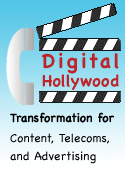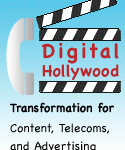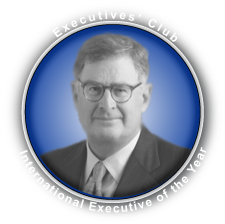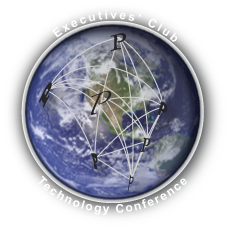Consumer Mistrust Will Slow the Reality of Mobile Personalization Vision
 Panelists at Digital Hollywood Chicago constantly spoke about mobile as the most “personal” of the three screens—for several reasons. The phone number is individual, so all the device’s activity can be attributed to a person, whose preferences and needs can be deduced from the activity. In addition, the mobile (phone) accompanies the individual almost everywhere, so it offers a wide scope of visibility into his/her activities, location and interactions. Panelists at Digital Hollywood Chicago constantly spoke about mobile as the most “personal” of the three screens—for several reasons. The phone number is individual, so all the device’s activity can be attributed to a person, whose preferences and needs can be deduced from the activity. In addition, the mobile (phone) accompanies the individual almost everywhere, so it offers a wide scope of visibility into his/her activities, location and interactions.
The mobile device will soon lose the “phone” moniker because the device morphing into a portable digital hub. “Smartphones” have seen much slower adoption than hoped, but functionality, power and capability are steadily increasing while prices fall. Apple’s iPhone was constantly mentioned as the promising breakthrough device.
Mobile devices will change relationships far more than the first screen (TV) or the second screen (computer) because they will touch everyone, their capabilities will rival laptops’ within 2-3 years, and they are inherently social. Social networking via video sharing, Web browsing, email, SMS, IM, music sharing and voice calling is on tap in the latest smartphones. The problem is, their features […]
The Challenge of Consumer/Advertising Misalignment: How to Finance Free Content
 At Digital Hollywood Chicago, few disputed that broadcast TV and mass advertising’s golden age had passed and that several technologies and cultural shifts were pressuring senior marketers to change. To fully appreciate this challenge, one has to consider the three screens through which most consumers experience “content. ” What consumers do with the changing capabilities of each screen changes their expectations and behaviors about their experience with all three screens, dramatically increasing opportunities and threats. Interactivity is increasingly available for TV (video). Convergence among the three screens is another important thread. Younger generations of consumers have little tolerance for the concept of mass advertising. At Digital Hollywood Chicago, few disputed that broadcast TV and mass advertising’s golden age had passed and that several technologies and cultural shifts were pressuring senior marketers to change. To fully appreciate this challenge, one has to consider the three screens through which most consumers experience “content. ” What consumers do with the changing capabilities of each screen changes their expectations and behaviors about their experience with all three screens, dramatically increasing opportunities and threats. Interactivity is increasingly available for TV (video). Convergence among the three screens is another important thread. Younger generations of consumers have little tolerance for the concept of mass advertising.
The most rapacious symptom of the weakness of the mass broadcast advertising model is the widespread adoption of the PVR (personal video recorder), which enables (home) viewers to record TV programs—and to skip advertisements. A couple of eye-opening facts: 1) on average, TV programming contains 8.5 minutes of advertisements during each 30 minute segment of programming and 2) 70% of adverts are fast-forwarded through or eliminated. And these numbers pertain to (mostly) non-digital (analog) […]
Mobile Video: A Perfect Storm for User-Generated Content?
 At Digital Hollywood Chicago, mobile was constantly heralded as the emerging “third screen” because it would enable content consumption regardless of time or place, and most speakers posited that video would grow significantly as a portion of all content. However, there is little video content available for mobile viewing, so why should consumers get excited about it? Will mobile shine as the most personal view into the consumer, or will it turn out to be the third wheel? At Digital Hollywood Chicago, mobile was constantly heralded as the emerging “third screen” because it would enable content consumption regardless of time or place, and most speakers posited that video would grow significantly as a portion of all content. However, there is little video content available for mobile viewing, so why should consumers get excited about it? Will mobile shine as the most personal view into the consumer, or will it turn out to be the third wheel?
All mobile value chain players are frenetically trying to build a new digital world around the mobile device, and this world will be comprised of the familiar triad: devices, networks and content, much of which will be video. Currently, video is the highest value content medium. This session examined the current stage of development to technology and business models.
Internet pioneers who remember the thrill of squealing modems connecting in the early days have a useful metaphor with which to regard video on mobile. We are very much in the early days: networks in most geos are inconsistent, and their ability to […]
Now Everyone Is a Producer—How Will User-Generated Content Affect Traditional Media?
 User-generated media (UGM) represents a poignant dichotomy within the context of Digital Hollywood Chicago: panelists and speakers represented a full spectrum of players that provide the capability for people to communicate, work and entertain themselves, but they have in common that they represent business interests. These players are in the business of commercializing communication. Consumers (aka “users,” “people”) represent personal interests: they communicate because they want to; they have little commercial interest in most of their communication. User-generated media (UGM) represents a poignant dichotomy within the context of Digital Hollywood Chicago: panelists and speakers represented a full spectrum of players that provide the capability for people to communicate, work and entertain themselves, but they have in common that they represent business interests. These players are in the business of commercializing communication. Consumers (aka “users,” “people”) represent personal interests: they communicate because they want to; they have little commercial interest in most of their communication.
Panelists grappled with this reality but did not address it directly. They explored business models for UGM—and mostly came up empty. The problem that UGM poses to providers is two-fold: UGM costs providers money in terms of bandwidth and other resources. It also carries a considerable opportunity cost, which is hard to measure but palpable: it crowds out commercial content by occupying customers in two ways: creating UGM and experiencing others’ UGM.
UGM is also difficult to compete against because its producers play by much different rules: they usually produce for free, while commercial producers have high costs. UGM producers […]
Leadership, Trust and the Globally Integrated Enterprise reports on IBM’s CEO as he articulated a prescient vision for the enterprise—adapting to the Knowledge Economy.
 Samuel J. Palmisano, Chairman, President and Chief Executive Officer of IBM Corporation, outlined a new version of the enterprise at a lunch honoring him with the Executives’ Club of Chicago’s Thirteenth Annual International Executive of the Year Award April 12, 2007 at the Chicago Hilton. Entitled “Leadership, Trust and the Globally Integrated Enterprise,” his speech emphasized key points from his Summer 2006 article of the same name in Foreign Affairs. He was especially interesting to hear due to his experience with leading one of the world’s foremost global enterprises as well as his insight from serving global enterprises in every industry. Samuel J. Palmisano, Chairman, President and Chief Executive Officer of IBM Corporation, outlined a new version of the enterprise at a lunch honoring him with the Executives’ Club of Chicago’s Thirteenth Annual International Executive of the Year Award April 12, 2007 at the Chicago Hilton. Entitled “Leadership, Trust and the Globally Integrated Enterprise,” his speech emphasized key points from his Summer 2006 article of the same name in Foreign Affairs. He was especially interesting to hear due to his experience with leading one of the world’s foremost global enterprises as well as his insight from serving global enterprises in every industry.
Yesterday’s model for the global enterprise, the multinational corporation (MNC), looks increasingly outdated due to widespread adoption of standards-based technology, increasingly standardized work processes and a liberalizing regulatory environment. Today, knowledge-based resources are available globally, and the enterprise’s means to create value is choosing how and where to tap the resources to […]
The Internet, E-Business and Web 2.0 in Context
 Web 2.0 and social networks readily appear as hype, but I will argue that they are actors in a much larger drama, the emergence of the Knowledge Economy, which is currently in its third phase, Web 2.0 and social networks. By understanding the transformation of relationships among your customers and between your customers and your company, you will be in a much better position to guide your company through this area of tremendous change. Web 2.0 and social networks readily appear as hype, but I will argue that they are actors in a much larger drama, the emergence of the Knowledge Economy, which is currently in its third phase, Web 2.0 and social networks. By understanding the transformation of relationships among your customers and between your customers and your company, you will be in a much better position to guide your company through this area of tremendous change.
The Ascendance of the Knowledge Economy
The Knowledge Economy is a post-industrial economy in which value is primarily created through information, and differentiation is achieved by explicitly focusing on customer experience itself rather than on products or services. The life cycles of products and services will increasingly shorten. Leaders of companies with products and services who do not understand this face rampant commoditization from which there is no escape except through unprecedented innovation. We are in the third phase of the growth of the Knowledge Economy in which it is transforming relationships. Each phase is ongoing, but the emphasis shifts over […]
Visions for Technology Leadership
 After Gary Forsee’s luncheon address, a diverse panel of executives took the stage to discuss global technology leadership. Hardik Bhatt, CIO of the City of Chicago, Steve Goldman, Director of Architecture, the Chicago Mercantile Exchange, Raymond Spencer, CEO of Kanbay International, and David Weick, Global CIO of McDonald’s, shared their visions for Chicago’s global role in the world. Janet Kennedy, Midwest General Manager of Microsoft, gracefully moderated the panel discussion. The Executives’ Club of Chicago’s quarterly Technology Conference took place March 8 at the Chicago Hilton. After Gary Forsee’s luncheon address, a diverse panel of executives took the stage to discuss global technology leadership. Hardik Bhatt, CIO of the City of Chicago, Steve Goldman, Director of Architecture, the Chicago Mercantile Exchange, Raymond Spencer, CEO of Kanbay International, and David Weick, Global CIO of McDonald’s, shared their visions for Chicago’s global role in the world. Janet Kennedy, Midwest General Manager of Microsoft, gracefully moderated the panel discussion. The Executives’ Club of Chicago’s quarterly Technology Conference took place March 8 at the Chicago Hilton.
“Getting global” can mean many things, and panelists hit the issue from many directions. I’ll venture that, more than anything, it means changing one’s mindset, focus and approach, all of which are difficult to measure. All panelists represented organizations that had had international operations for decades, so how is global different?
[…]
How to Increase Your Payback from Using LinkedIn
 LinkedIn is a “social” site that will prove to be of rare benefit to business executives and professionals in building individualized collaborative networks, as I explained in detail in the GHCJ Review of LinkedIn. However, LinkedIn is seriously lacking in providing a step-by-step guide to help the motivated executive to tap its real value. The functionality of the website is easy to use, but many of the finer points of LinkedIn are lost on the majority of users. This guide attempts to address that. LinkedIn is a “social” site that will prove to be of rare benefit to business executives and professionals in building individualized collaborative networks, as I explained in detail in the GHCJ Review of LinkedIn. However, LinkedIn is seriously lacking in providing a step-by-step guide to help the motivated executive to tap its real value. The functionality of the website is easy to use, but many of the finer points of LinkedIn are lost on the majority of users. This guide attempts to address that.
[…]
Valuable Space to Create Your Professional Knowledge Network
 LinkedIn is a social network website that enables people to build and manage (mostly) business connections in order to discover jobs, ventures, new clients, etc. Unlike other social networking sites, its focus is business rather than social or entertainment. LinkedIn is a social network website that enables people to build and manage (mostly) business connections in order to discover jobs, ventures, new clients, etc. Unlike other social networking sites, its focus is business rather than social or entertainment.
LinkedIn is emerging as a dominant networking environment for executives and professionals, and its development will be of interest as both an immensely practical tool and as a study of the social network phenomenon. Founded in 2003, LinkedIn crossed the chasm in 2007, as the company reports that thousands of people are joining per day. Today, it has more than 9 million members, and membership is very global.
As valuable as LinkedIn is, one of the company’s weakest points is making itself approachable to executives. For example, I recently attended an Illinois IT Association Sales Round Table at which attendees represented a broad range of executives, IT management and professionals and were no strangers to developing relationships and business development. Presenter Steve Weinberg gave an excellent presentation on LinkedIn’s potential and features. Listening to the interaction of the at-capacity crowd, I was impressed by […]
![Payment Processor Wins Web 0.2 Citation for Delivering "Yechsperience" [customer experience satire]](http://rollyson.net/wp-content/uploads/2007/03/webdot2-logo.png) Achieves Payor of Last Resort Status Achieves Payor of Last Resort Status
Chicago, 13 March 2007—Today, the Global Human Capital Journal awarded StaySmall, the global payment intermediary, the odious Web 0.2 Citation for inducing a poignant bout of customer yechsperience™.
As readers know, the GHCJ exercises stringent criteria before conferring the Web 0.2 Citation: to earn it, companies must induce prolonged feelings of frustration, confusion and anguish in customers more effectively than their competitors.
Tonight, StaySmall delivered in spades, as reported by the judges. Here is a summarized account of the findings…
[…]
|
|
 Panelists at Digital Hollywood Chicago constantly spoke about mobile as the most “personal” of the three screens—for several reasons. The phone number is individual, so all the device’s activity can be attributed to a person, whose preferences and needs can be deduced from the activity. In addition, the mobile (phone) accompanies the individual almost everywhere, so it offers a wide scope of visibility into his/her activities, location and interactions.
Panelists at Digital Hollywood Chicago constantly spoke about mobile as the most “personal” of the three screens—for several reasons. The phone number is individual, so all the device’s activity can be attributed to a person, whose preferences and needs can be deduced from the activity. In addition, the mobile (phone) accompanies the individual almost everywhere, so it offers a wide scope of visibility into his/her activities, location and interactions.
 At Digital Hollywood Chicago, mobile was constantly heralded as the emerging “third screen” because it would enable content consumption regardless of time or place, and most speakers posited that video would grow significantly as a portion of all content. However, there is little video content available for mobile viewing, so why should consumers get excited about it? Will mobile shine as the most personal view into the consumer, or will it turn out to be the third wheel?
At Digital Hollywood Chicago, mobile was constantly heralded as the emerging “third screen” because it would enable content consumption regardless of time or place, and most speakers posited that video would grow significantly as a portion of all content. However, there is little video content available for mobile viewing, so why should consumers get excited about it? Will mobile shine as the most personal view into the consumer, or will it turn out to be the third wheel? Samuel J. Palmisano, Chairman, President and Chief Executive Officer of IBM Corporation, outlined a new version of the enterprise at a lunch honoring him with the Executives’ Club of Chicago’s Thirteenth Annual International Executive of the Year Award April 12, 2007 at the Chicago Hilton. Entitled “Leadership, Trust and the Globally Integrated Enterprise,” his speech emphasized key points from his Summer 2006 article of the same name in Foreign Affairs. He was especially interesting to hear due to his experience with leading one of the world’s foremost global enterprises as well as his insight from serving global enterprises in every industry.
Samuel J. Palmisano, Chairman, President and Chief Executive Officer of IBM Corporation, outlined a new version of the enterprise at a lunch honoring him with the Executives’ Club of Chicago’s Thirteenth Annual International Executive of the Year Award April 12, 2007 at the Chicago Hilton. Entitled “Leadership, Trust and the Globally Integrated Enterprise,” his speech emphasized key points from his Summer 2006 article of the same name in Foreign Affairs. He was especially interesting to hear due to his experience with leading one of the world’s foremost global enterprises as well as his insight from serving global enterprises in every industry. Web 2.0 and social networks readily appear as hype, but I will argue that they are actors in a much larger drama, the emergence of the Knowledge Economy, which is currently in its third phase, Web 2.0 and social networks. By understanding the transformation of relationships among your customers and between your customers and your company, you will be in a much better position to guide your company through this area of tremendous change.
Web 2.0 and social networks readily appear as hype, but I will argue that they are actors in a much larger drama, the emergence of the Knowledge Economy, which is currently in its third phase, Web 2.0 and social networks. By understanding the transformation of relationships among your customers and between your customers and your company, you will be in a much better position to guide your company through this area of tremendous change. After Gary Forsee’s luncheon address, a diverse panel of executives took the stage to discuss global technology leadership. Hardik Bhatt, CIO of the City of Chicago, Steve Goldman, Director of Architecture, the Chicago Mercantile Exchange, Raymond Spencer, CEO of Kanbay International, and David Weick, Global CIO of McDonald’s, shared their visions for Chicago’s global role in the world. Janet Kennedy, Midwest General Manager of Microsoft, gracefully moderated the panel discussion. The Executives’ Club of Chicago’s quarterly Technology Conference took place March 8 at the Chicago Hilton.
After Gary Forsee’s luncheon address, a diverse panel of executives took the stage to discuss global technology leadership. Hardik Bhatt, CIO of the City of Chicago, Steve Goldman, Director of Architecture, the Chicago Mercantile Exchange, Raymond Spencer, CEO of Kanbay International, and David Weick, Global CIO of McDonald’s, shared their visions for Chicago’s global role in the world. Janet Kennedy, Midwest General Manager of Microsoft, gracefully moderated the panel discussion. The Executives’ Club of Chicago’s quarterly Technology Conference took place March 8 at the Chicago Hilton. LinkedIn is a “social” site that will prove to be of rare benefit to business executives and professionals in building individualized collaborative networks, as I explained in detail in the GHCJ Review of LinkedIn. However, LinkedIn is seriously lacking in providing a step-by-step guide to help the motivated executive to tap its real value. The functionality of the website is easy to use, but many of the finer points of LinkedIn are lost on the majority of users. This guide attempts to address that.
LinkedIn is a “social” site that will prove to be of rare benefit to business executives and professionals in building individualized collaborative networks, as I explained in detail in the GHCJ Review of LinkedIn. However, LinkedIn is seriously lacking in providing a step-by-step guide to help the motivated executive to tap its real value. The functionality of the website is easy to use, but many of the finer points of LinkedIn are lost on the majority of users. This guide attempts to address that. LinkedIn is a social network website that enables people to build and manage (mostly) business connections in order to discover jobs, ventures, new clients, etc. Unlike other social networking sites, its focus is business rather than social or entertainment.
LinkedIn is a social network website that enables people to build and manage (mostly) business connections in order to discover jobs, ventures, new clients, etc. Unlike other social networking sites, its focus is business rather than social or entertainment.![Payment Processor Wins Web 0.2 Citation for Delivering "Yechsperience" [customer experience satire]](http://rollyson.net/wp-content/uploads/2007/03/webdot2-logo.png) Achieves Payor of Last Resort Status
Achieves Payor of Last Resort Status